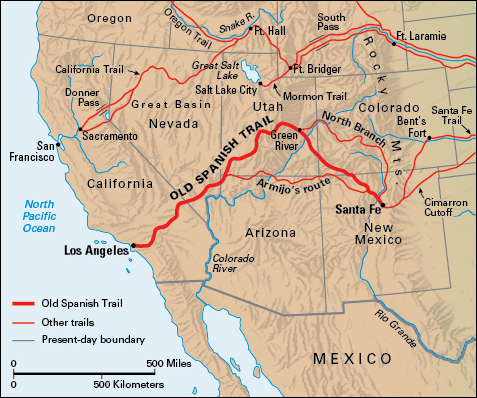Old Spanish Trail was a trade route in what is now the southwestern United States . The route, completed in 1829, was a westward expansion of the legendary Santa Fe Trail . The Old Spanish Trail connected Santa Fe , in what is now New Mexico , to Los Angeles , in California . Mule trains on the trail traversed rocky, arid country. The trail declined in importance following the Mexican War (1846-1848), when traders forged new, wagon-friendly routes to California.
Background.
The years following the American Revolution (1775-1783) were a period of westward expansion for the United States. The nation gained vast amounts of territory between the Mississippi River and the Rocky Mountains with the Louisiana Purchase of 1803. In 1821, Mexico gained its independence from Spain . That same year, the American trader William Becknell opened the Santa Fe Trail. Following routes pioneered by Native Americans, the trail connected trading posts in western Missouri with the commercial center of Santa Fe, New Mexico. At that time, New Mexico was a province of Mexico.
Routes of the Old Spanish Trail.
Over the winter of 1829 to 1830, an expedition led by the Mexican trader Antonio Armijo opened the first branch of what became the Old Spanish Trail. The trail may have been given its name because of the Spanish explorers who had traveled parts of the route during the 1700’s. Armijo’s route ran northwest from Santa Fe before taking a westerly direction along the northern border of what is now Arizona . His path then turned southwest across what is now southern Nevada , before continuing to Los Angeles. Los Angeles was at the time a small farming community in the Mexican province of California.

American frontiersmen William Wolfskill and George C. Yount forged the trail’s main route in 1830 and 1831. It ran northwest from Santa Fe to what is now central Utah . It then turned southwest toward Los Angeles, covering more than 1,000 miles (1,600 kilometers). An additional route, known as the North Branch, ran northward to what is now south-central Colorado . This branch linked up with the main trail at what is now Green River, Utah.
Each of the Old Spanish Trail’s routes avoided the difficult terrain near the Grand Canyon . Even so, people could only travel the trails on foot or atop such pack animals as horses or mules.
The Old Spanish Trail flourished for about 20 years. Trading caravans transported goods and livestock between Santa Fe and Los Angeles. Traders often exchanged woolen goods and animal hides for horses and mules bred on the ranches of southern California. Traders from China , arriving by ship at Los Angeles, also participated in the commercial exchange.
Later years.
The trail fell into disuse after 1848, following the Mexican War. Under the terms of the Treaty of Guadalupe Hidalgo , Mexico ceded much of its northern territory to the United States. Traders soon pioneered more direct, less dangerous wagon routes from the Southwest interior to the Pacific Ocean . By the late 1800’s, the extension of railroads into southern California made even the newer wagon trails obsolete.
Today, traces of the Old Spanish Trail are still evident in the hard-packed earth once trod by thousands of mules. The Old Spanish Trail Association partners with the National Park Service , the Bureau of Land Management , and a number of private and governmental organizations to preserve and mark sections of the historic route.
